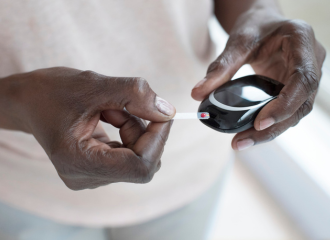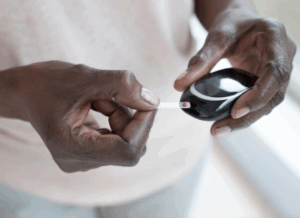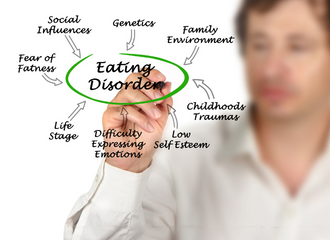Written By: Samantha Wint MPH, RDN, LDN
Director of Nutrition at The Renfrew Center of Florida
 What Causes Diabetes?
What Causes Diabetes?
Diabetes is a chronic condition that is marked by high blood glucose (sugar) levels, often requiring long-term management. Glucose is the primary source of fuel (energy) for the body. Insulin is a hormone produced in the pancreas that is responsible for allowing your body to get glucose (sugar) from the foods you eat. If your body doesn’t produce insulin, produces too little, or can’t use it effectively, this results in too much sugar in your blood, which over time can cause significant medical problems.
Types of Diabetes
Type 1 (Insulin Dependent): This type occurs when the immune system attacks the insulin-producing cells in the pancreas, causing them to produce little to no insulin. This results in a lifelong dependency on insulin. It is typically diagnosed in childhood, but it can occur at any age.
Type 2: This type occurs when the pancreas does not produce enough insulin or is not effective in lowering blood sugars (insulin resistance). It was once known as adult-onset diabetes, but it is becoming more common among younger people.
Gestational: This term ‘gestation’ means the growth and development of a child in its mother’s womb. So, this type of diabetes occurs during pregnancy. However, it can increase the risk of developing type 2 diabetes later in life.
Prediabetes: Occurs when your blood sugars are high but not enough to be diagnosed with diabetes. You may or may not have symptoms.
Common Symptoms of Diabetes
- Increased thirst & dry mouth
- Increased hunger even when you are eating enough
- Blurred vision
- Extreme fatigue
- Unintentional weight loss
- Excessive urinating
- Slow wound healing
Unusual Symptoms of High Blood Glucose/Diabetes
- Recurring skin or vaginal yeast infection
- Acanthosis Nigricans – characterized by dark, thick patches in skin folds located in areas such as the back of the neck, groin area, armpits, knuckles, and underneath the breasts.
- Skin tags – small growths that project out of the skin.
- Fruity breath
- Itchy skin
- Mood changes – feeling irritable and cranky all the time.
Effects of High Blood Sugar
When blood sugar remains high without proper intervention, over time, this can lead to medical complications, including stroke, amputations, blindness, kidney damage, and heart disease.
Diabetic Ketoacidosis (DKA) is a life-threatening complication of diabetes that can lead to coma or death if not treated properly. It’s not the same as ‘ketosis,’ which occurs during fasting or when your carbohydrate intake is too low. DKA occurs primarily due to the body not getting adequate insulin. This is common in individuals with eating disorders who are insulin dependent and who withhold it for the sole purpose of losing weight.
Test Your Knowledge About Diabetes
Myth #1: People with diabetes should avoid eating sweets.
Fact: Individuals with diabetes can incorporate sweets as a part of a healthy diet, but moderation and portion control are important. It is unrealistic to avoid sweets, and a deprivation mindset can contribute to disordered eating.
Myth #2: You will develop diabetes if you are overweight.
Fact: Diabetes is multifaceted and is not developed from just a single factor. Some risk factors are things that you can change (modifiable) and others you can’t change (non-modifiable).
Modifiable: physical activity, blood pressure, smoking
Non-Modifiable: family history, age, race/ethnicity, gestational diabetes
Myth #3: If I eat a lot of sugar, I will get diabetes.
Fact: The answer is simply no. Diabetes is a medical condition that develops because of problems with the pancreas or insulin resistance. For people living with diabetes, knowing how certain foods affect blood sugar can help them manage the condition, but enjoying foods with sugar is possible and does not automatically cause diabetes.
Myth #4: Getting a diabetes diagnosis means I am unhealthy.
Fact: “Healthy” is a complex concept, shaped by many factors, and can be interpreted in ways that might be misleading or overly simplistic. Being healthy does not mean the absence of illness. In fact, you can live a long, healthy life with the right tools/knowledge to help manage this chronic condition. The World Health Organization defines health as “a state of complete physical, mental, and social well-being and not merely the absence of disease or infirmity.”
Myth #5: You must follow a “special” diet when you have diabetes.
Fact: There isn’t a single “diabetes diet” that everyone has to follow. Various eating plans that can support blood sugar management. This often includes paying attention to how different foods effect blog sugar and prioritizing foods that provide fiber, nutrients and steady energy – while recognizing all foods can have a place in daily eating.
Diabetes and Co-Occurring Conditions
Eating disorders rarely travel alone. Often, individuals with eating disorders also have chronic illnesses, including diabetes, Crohn’s disease, Celiac disease, Irritable Bowel disease, and severe food allergies. Managing these conditions can involve eliminating certain foods, tracking intake, and paying close attention to food labels, ingredients, or nutrients. For some people, this increased focus on food and numbers may increase vulnerability to developing disordered eating or an eating disorder.
Type 1 Diabetes and Eating Disorders
Contrary to popular beliefs, eating disorders are not just about food and weight. The Renfrew Center’s treatment approach conceptualizes eating disorders as emotional disorders. Individuals with eating disorders use symptoms as a means of coping with a variety of stressors that feel intolerable or unmanageable. These symptoms, such as restricting, bingeing, or purging, can provide temporary relief from unpleasant emotional experiences, but over time, they become reinforced and contribute to a repeating, harmful cycle.
Due to the complex interplay between the eating disorder and a chronic illness such as diabetes, treatment is multifaceted. At the Renfrew Center, we offer a multidisciplinary team approach to treating diabetes. Our emotion-focused treatment model creates awareness of the emotions underlying the diverse issues that drive eating disorders, such as living with diabetes, while utilizing evidence-based treatment interventions to promote psychological growth and sustain behavioral change. The Renfrew Center offers comprehensive treatment and education for diabetes based on the Standards of Medical Care for Diabetes published by the American Diabetes Association (ADA). Our nutrition approach aims to 1) promote healthful eating patterns through the inclusion of all food groups, 2) attain glycemic control, 3) delay or prevent complications, and 4) promote joyful eating by providing nonjudgmental messages about food choices.
The intentional focus on food and weight in the treatment of T1DM can set the stage for the development of an eating disorder. Research indicates that women with T1DM are at increased risk of developing an eating disorder compared to women without T1DM (Hanlan et al., 2013).
What is Diabulimia?
Diabulimia (ED-DMT1) refers to an individual who has both an eating disorder and type 1 diabetes. Individuals with this eating disorder withhold or omit insulin for the sole purpose of losing weight.
Risk Factors for Diabulimia
- Focus on weight, numbers, and dietary restraint
- ‘Good’ or ‘bad’ foods
- Prior eating disorder history
- Weight gain at the start of insulin therapy
- Psychological effects of chronic disease
- Familial and other societal factors
- Depression and anxiety
- Poor body image
Warning Signs for Diabulimia
- Consistently high hemoglobin A1c
- Constant fatigue
- Body image concerns
- Manipulation of insulin
- Irregular eating patterns
- Obsessive reading of food labels
- Significant weight fluctuations/loss
- Compulsive exercise
- Irregular menses or amenorrhea
- Frequent hospitalizations with episodes of DKA
- Unwillingness to attend appointments
- Inconsistency between blood glucose meter and A1c levels
Dangers of Insulin Omission
- Complications occur earlier in life
- Duration of severe insulin omission is the factor most associated with retinopathy (eye disease) and neuropathy (nerve disease) in women with ED-DMT1
- Increased risk of death
Conclusion
Diabetes is a complex, chronic condition that extends far beyond high blood sugar levels. When combined with eating disorders, it presents unique challenges that require compassionate, comprehensive care. By addressing the myths, risks, and emotional components, we can break down stigma, support those affected, and promote overall health and well-being. Seeking care from professionals who are experienced in both diabetes and eating disorders is key to helping individuals navigate these challenges safely and effectively.
References
- “Know your facts about diabetes.” (n.d.) American Diabetes Association. https://diabetes.org/about-diabetes/diabetes-myths
- Hanlan ME, Griffith J, Patel N, Jaser SS. Eating Disorders and Disordered Eating in Type 1 Diabetes: Prevalence, Screening, and Treatment Options. Curr Diab Rep. 2013 Sep 12:10.1007/s11892-013-0418-4. doi: 10.1007/s11892-013-0418-4. Epub ahead of print. PMID: 24022608; PMCID: PMC4002640.
- National Alliance for Eating Disorders. (2024, August 27). The intersection of eating disorders and chronic illnesses. https://www.allianceforeatingdisorders.com/the-intersection-of-eating-disorders-and-chronic-illnesses/
- The Renfrew Center’s Diabetes Treatment Program Patient Workbook
- World Health Organization Constitution. WHO remains firmly committed to the principles set out in the preamble to the Constitution. https://www.who.int/about/governance/constitution (accessed 23 July 2025).

 What Causes Diabetes?
What Causes Diabetes?

